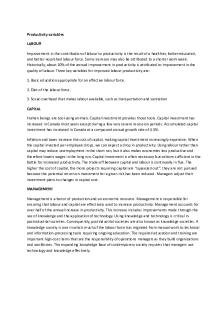17 - Isolating Variables PDF

| Title | 17 - Isolating Variables |
|---|---|
| Author | M. T. |
| Course | Math (Grade 9) |
| Institution | High School - Canada |
| Pages | 4 |
| File Size | 276.3 KB |
| File Type | |
| Total Downloads | 31 |
| Total Views | 139 |
Summary
Notes...
Description
17 - Isolating Variables
MPM1D – Polynomials and Equations
Date: ____________________________________________
Isolating Variables Formulae are special kinds of equations. They describe relationships between quantities of interest. You already know several formulae. Area of a rectangle:
_________________________________
Perimeter of a rectangle:
_________________________________
Circumference of a circle:
_________________________________
Area of a circle:
_________________________________
Area of a triangle:
_________________________________
We can use existing/given formulae to solve a problem. When using a formula, we always: •
isolate the desired unknown variable on the left side of the equal sign
•
show our substitution of all known variables and all calculations
•
state our final answer with the appropriate units (if given)
Examples: 1) Solve each formula for the indicated variable. a) = for
b) = ℎ for ℎ
d) = 2 + 2 for
e)
= for
Page 1 of 4
c) = ℎ for
f)
=
for
17 - Isolating Variables
MPM1D – Polynomials and Equations
2) The formula for estimating a dog’s age in equivalent human years, h, is ℎ = 5 + 12, where d is the dog’s age in actual years. Find Odie’s actual age if he is 47 in equivalent human years.
3) The formula, = , where t is the time in seconds between the lightning flash and the thunder, provides a convenient rule of thumb for estimating how many kilometres away a storm is. a) How far away is the storm if 15 seconds elapse between the flash of lightning and the thunder?
b) How many seconds separate the lightning and the thunder if the storm is 6 kilometres away?
Page 2 of 4
17 - Isolating Variables
MPM1D – Polynomials and Equations
Homework 1. Solve the formula for the variable indicated. You may first need to simplify the formula. !
a) = ,
b) = , # "
c) $ = 2,
h) = 2 + ,
i) 3 = 4 + ,
f) / = 1801 − 2 , 1
e) ( = ) − 30-,.-
d) % = &' , '
g) - = 3 + 2, j) 3 = 4 − ,
k) / = 5
67
8 -, )
l)
9
= ,
2. To find t for different values of u and v in an experiment, a calculator is to be used. Express t in terms of the other variables, ( = ) − 30- and then find the values of t for each of the following values of u and v. Round to one decimal place. a) ) = 28, ( = 36
b) ) = 28.5, ( = 23.2
c) ) = 146.3, ( = 189.8
Answers 1. >
a) = ?
b) # = @
e) - =
f) 1 = G + 2
6 E 7 E
i) =
HI J
F
j)
b) 9.1
d) ' = D
h) = −
C
H
= 4−K
g) = − 2 k) ) =
F
2. a) –17.1
A
c) = B
c) –487.3
Page 3 of 4
−(
l) = 2 + 2
17 - Isolating Variables
MPM1D – Polynomials and Equations
Page 4 of 4...
Similar Free PDFs

17 - Isolating Variables
- 4 Pages

Lab 1: Isolating Caffeine
- 8 Pages

Variables
- 5 Pages

Productivity variables
- 1 Pages

Variables Aleatorias
- 3 Pages

Forms (Variables)
- 2 Pages

Variables Bidimensionales
- 5 Pages

Independent variables
- 8 Pages

17 - Chapter 17
- 23 Pages

Tema 17 - Apuntes 17
- 6 Pages

TEMA 17 - Apuntes 17
- 9 Pages

Funciones de varias variables
- 1 Pages

Variables mecanicas - Apuntes 1
- 9 Pages
Popular Institutions
- Tinajero National High School - Annex
- Politeknik Caltex Riau
- Yokohama City University
- SGT University
- University of Al-Qadisiyah
- Divine Word College of Vigan
- Techniek College Rotterdam
- Universidade de Santiago
- Universiti Teknologi MARA Cawangan Johor Kampus Pasir Gudang
- Poltekkes Kemenkes Yogyakarta
- Baguio City National High School
- Colegio san marcos
- preparatoria uno
- Centro de Bachillerato Tecnológico Industrial y de Servicios No. 107
- Dalian Maritime University
- Quang Trung Secondary School
- Colegio Tecnológico en Informática
- Corporación Regional de Educación Superior
- Grupo CEDVA
- Dar Al Uloom University
- Centro de Estudios Preuniversitarios de la Universidad Nacional de Ingeniería
- 上智大学
- Aakash International School, Nuna Majara
- San Felipe Neri Catholic School
- Kang Chiao International School - New Taipei City
- Misamis Occidental National High School
- Institución Educativa Escuela Normal Juan Ladrilleros
- Kolehiyo ng Pantukan
- Batanes State College
- Instituto Continental
- Sekolah Menengah Kejuruan Kesehatan Kaltara (Tarakan)
- Colegio de La Inmaculada Concepcion - Cebu


